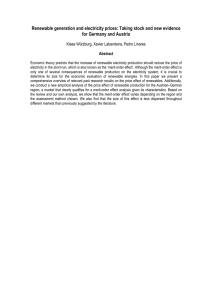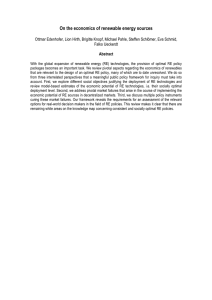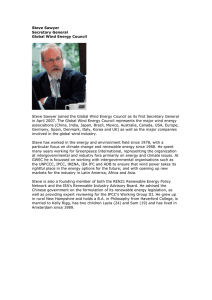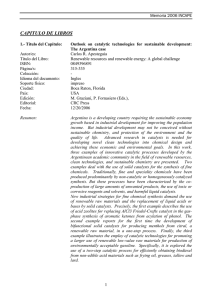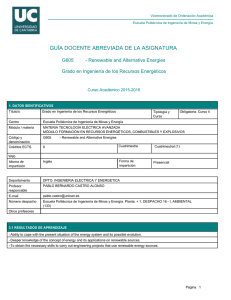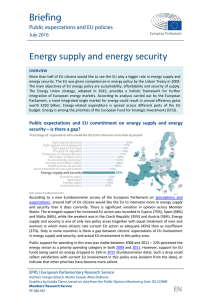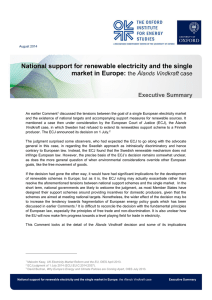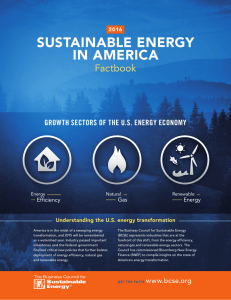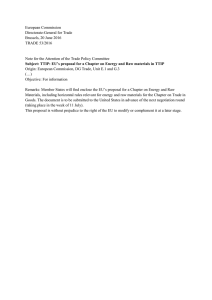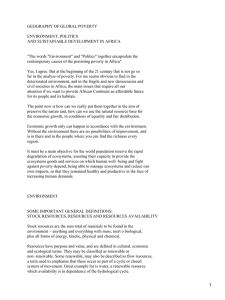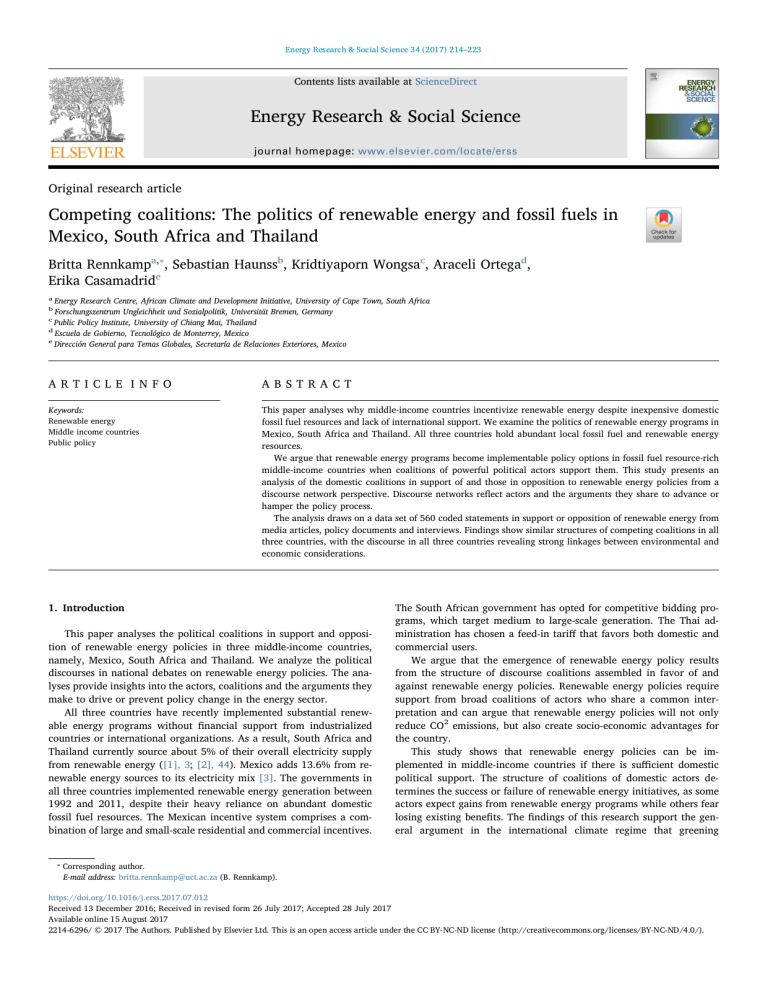
Energy Research & Social Science 34 (2017) 214–223 Contents lists available at ScienceDirect Energy Research & Social Science journal homepage: www.elsevier.com/locate/erss Original research article Competing coalitions: The politics of renewable energy and fossil fuels in Mexico, South Africa and Thailand T ⁎ Britta Rennkampa, , Sebastian Haunssb, Kridtiyaporn Wongsac, Araceli Ortegad, Erika Casamadride a Energy Research Centre, African Climate and Development Initiative, University of Cape Town, South Africa Forschungszentrum Ungleichheit und Sozialpolitik, Universität Bremen, Germany c Public Policy Institute, University of Chiang Mai, Thailand d Escuela de Gobierno, Tecnológico de Monterrey, Mexico e Dirección General para Temas Globales, Secretaría de Relaciones Exteriores, Mexico b A R T I C L E I N F O A B S T R A C T Keywords: Renewable energy Middle income countries Public policy This paper analyses why middle-income countries incentivize renewable energy despite inexpensive domestic fossil fuel resources and lack of international support. We examine the politics of renewable energy programs in Mexico, South Africa and Thailand. All three countries hold abundant local fossil fuel and renewable energy resources. We argue that renewable energy programs become implementable policy options in fossil fuel resource-rich middle-income countries when coalitions of powerful political actors support them. This study presents an analysis of the domestic coalitions in support of and those in opposition to renewable energy policies from a discourse network perspective. Discourse networks reflect actors and the arguments they share to advance or hamper the policy process. The analysis draws on a data set of 560 coded statements in support or opposition of renewable energy from media articles, policy documents and interviews. Findings show similar structures of competing coalitions in all three countries, with the discourse in all three countries revealing strong linkages between environmental and economic considerations. 1. Introduction This paper analyses the political coalitions in support and opposition of renewable energy policies in three middle-income countries, namely, Mexico, South Africa and Thailand. We analyze the political discourses in national debates on renewable energy policies. The analyses provide insights into the actors, coalitions and the arguments they make to drive or prevent policy change in the energy sector. All three countries have recently implemented substantial renewable energy programs without financial support from industrialized countries or international organizations. As a result, South Africa and Thailand currently source about 5% of their overall electricity supply from renewable energy ([1], 3; [2], 44). Mexico adds 13.6% from renewable energy sources to its electricity mix [3]. The governments in all three countries implemented renewable energy generation between 1992 and 2011, despite their heavy reliance on abundant domestic fossil fuel resources. The Mexican incentive system comprises a combination of large and small-scale residential and commercial incentives. ⁎ The South African government has opted for competitive bidding programs, which target medium to large-scale generation. The Thai administration has chosen a feed-in tariff that favors both domestic and commercial users. We argue that the emergence of renewable energy policy results from the structure of discourse coalitions assembled in favor of and against renewable energy policies. Renewable energy policies require support from broad coalitions of actors who share a common interpretation and can argue that renewable energy policies will not only reduce CO2 emissions, but also create socio-economic advantages for the country. This study shows that renewable energy policies can be implemented in middle-income countries if there is sufficient domestic political support. The structure of coalitions of domestic actors determines the success or failure of renewable energy initiatives, as some actors expect gains from renewable energy programs while others fear losing existing benefits. The findings of this research support the general argument in the international climate regime that greening Corresponding author. E-mail address: [email protected] (B. Rennkamp). https://doi.org/10.1016/j.erss.2017.07.012 Received 13 December 2016; Received in revised form 26 July 2017; Accepted 28 July 2017 Available online 15 August 2017 2214-6296/ © 2017 The Authors. Published by Elsevier Ltd. This is an open access article under the CC BY-NC-ND license (http://creativecommons.org/licenses/BY-NC-ND/4.0/). Energy Research & Social Science 34 (2017) 214–223 B. Rennkamp et al. issues: Bulkeley’s [24] study on climate policy in Australia, Mander’s [25] work on discourse coalitions related to wind energy deployment in the United Kingdom, and Szarka’s [26] research on coalitions existing within the wind sector in the United Kingdom, Denmark and France. Rennkamp [27] analyses discourse coalition enabling or hindering institutional change in the South African climate policy regime. Bulkeley [24], Mander [25] and Rennkamp [27] mainly focus on the emergence of competing, and sometimes cooperating, coalitions in the area of renewable energy and climate politics. Szarka [26] offers a more general interpretation of the interplay between discourse coalitions and environmental government policies. Following Rydin [28], Szarka [26] proposes that discourse coalitions can and must address Rydin’s three rationalities of the environmental discourse. These rationalities include the scientific rationality (environmental sustainability), economic rationality, and communicative rationality (inclusion and participation). Szarka [26] adds a fourth rationality, the reference to ethical–normative values. He argues that policy success of actor coalitions in support of wind energy rests mainly on the actors’ skillful use of ethical-normative arguments, thus “side-stepping indeterminacies within the expert discourses of science and economics” ([26], 328). We apply these categories to the discourse on renewable energy in Mexico, South Africa and Thailand. economic activities can achieve both emissions reductions and advance socio-economic development; in turns this undermines the assumption of a trade-off between the two objectives [4,5]. 2. On renewable energy diffusion, climate change and discourse coalitions: a literature review The research literature has identified several barriers to the diffusion and implementation of renewable energy programs, notably market failure and distortions, the lack of economic and financial resources, institutional barriers, the lack of technology or technological knowledge and social, cultural and behavioral barriers [6–8]. Researchers have argued that energy efficiency and renewable energy programs result in trade-offs between emissions reduction and development, and that governments in developing countries typically prioritize economic growth agendas over efforts for emissions reductions [9,10]. This does not mean that the barriers mentioned above cannot be overcome. Cost saving through energy efficiency and renewable energy programs has been identified as opportunities to create win-win situations in which emissions reduction and economic development go hand in hand [9]. A growing body of literature assesses the problem between climate and development policies from the perspective of so-called “cobenefits”. Co-benefits or co-impacts serve to conceptualize actions that have multiple purposes; these can be emissions reductions and their implications for socio-economic development, health, and water and vice versa [11,12]. Further, the research highlights economic and political barriers that cause the failure of renewable energy programs in developing countries despite potential co-benefits [13]. Political barriers cannot be reduced to a single factor as they result from complex interactions between institutions, organizations and individual actors with vested interests that collectively form issue-centered policies or political networks [14,15]. Their position is challenged by opposing networks trying to overcome existing political barriers, in this case advocating renewable energy policies. These competing networks interact on various levels. Most importantly, they interact in the public sphere in an attempt to find support for their respective positions. In the public sphere, they become visible as discourse coalitions, that is, groups of actors who share a social construct or an interpretation of the issue at stake and the policies needed to address the issue ([16], 46). Hajer’s notion of discourse coalitions is in many aspects similar to the concept of advocacy coalitions advanced by Sabatier and his collaborators (e.g. [17]), but does not include similarly strong assumptions about the general structure of actor belief systems, according to which advocacy coalitions are held together by shared deep core or at least policy core beliefs. Hajer instead focuses on shared interpretations, storylines and frames – aspects that can be observed even without knowledge of underlying belief systems. Our analyses of renewable energy policies in Thailand, South Africa, and Mexico focus on these discourse coalitions and draw on the growing literature on policy and discourse networks and discourse coalitions [16,18–23]. This perspective allows identifying the relevant coalitions in support of and those opposed to renewable energy policies in each country. The discursive interactions between these actors reveal the various propositions and use of specific arguments to advance their respective claims. Discursive interaction generates complex connections between actors, which are expressed in the shared or opposing arguments in order to support or oppose renewable energy policies. Analyzing the complexity of this discursive web requires a method that is able to reflect the relational nature of discursive interactions. Network analysis provides the appropriate relational analytical tools for a large number of statements made by many actors. Apart from Hajer’s [18] conceptual work on discourse coalitions in environmental policies in Britain, few studies have analyzed discourse networks related to renewable energy or climate mitigation policy 3. Methodology Discourse coalitions can be examined in every discursive arena in which various actors position themselves discursively and interact with or respond to other actors’ interventions. This discursive interaction generates complex connections between actors who make the same claims or use the same arguments to support their claims or contradict other actors’ claims. The analysis of complex discourse networks requires a method that is able to deal with the relational nature of the discursive interaction. Classical qualitative text-analytical methods are suitable for small numbers of statements and actors. For a large number of statements from many actors over long periods of time, discourse network analysis offers better ways to capturing the complex patterns of discursive interaction. We conceptualize the discourse about renewable energy policies in the three countries under study as discourse networks [22,23]. The nodes of discourse networks are the actors involved and the arguments (or frames) they use. The resulting network contains two separate classes of nodes: actors and arguments (Fig. 1). Discourse networks belong to the class of affiliation or bipartite networks [29] where links (or edges) can only exist between nodes of different classes. In discourse networks, a link between two nodes in the network is formed when an actor uses a specific argument in her statement. Conceptualizing legitimation discourse as affiliation networks makes it possible to identify the discursive relationships between actors that emerge when different actors use the same arguments or make the same claims. These indirect connections between actors should be interpreted as discourse coalitions, as conceptualized by Hajer. Discourse coalitions are one of two possible co-occurrence networks, which result from a projection of the original affiliation network onto either the actors or their arguments. Affiliation networks produce links between actors whenever they share one or more arguments. Actors connect through a link if they use the same argument. The thickness of the links between actors varies depending on the number of arguments they share. Concept networks show the links whenever they apply to the same actor. In this case, a higher link or edge weight reflects the simultaneous use of two (or more) arguments by several actors. Concept networks should be interpreted as repertoires or clusters of arguments used by one or more actors. Network analysis allows us to identify network topographies and to determine the importance of an individual actor or an individual argument within the overall discourse network. We can measure the importance of individual nodes depending on their centrality. In this 215 Energy Research & Social Science 34 (2017) 214–223 B. Rennkamp et al. Fig. 1. Model of a discourse network. Source: own. The renewable energy discourses in the three countries reflect different characteristics of the political economies in each country’s renewable energy sector even though all are similar in size and have similar actors. In the following sections, we provide an overview of current renewable energy policies in each country and analyze the structures of the renewable energy discourse coalitions for each country. We conclude with a systematic synthesis of the findings in all three countries. study, we use measure of hub centrality, because we focus not only on individual nodes, but also on the relation to other nodes.1 An actor has a particularly high hub centrality if she uses arguments that other actors share, who again use the most common arguments to which many other actors refer. Similarly, the hub centrality of an argument depends on whether many actors use it. An actor with a high hub centrality value thus acts as a “hub” within the network, which translates into relatively strong discursive authority. Arguments with high hub centrality values are usually core elements of a complex and coherent argument consisting of a range of densely connected concepts. The current study originally coded individual actors and their statements about the renewable energy programs in Mexico, Thailand and South Africa. The selection of the countries of study followed the logic of a similar case study design. All three countries are highly fossil fuel dependent, semi-industrialized developing countries. Their governments implemented renewable energy programs without significant international climate financial support. The structure of the discourse coalitions in support and opposition of renewable energy differ between countries. Individual actors have been aggregated according to actor categories to allow for a meaningful comparison between the three countries. The database consists of 560 coded statements in the independent media, policy documents, parliamentary notes in combination with 75 interviews in the period from 2008 to 2015. 4.1. Renewable energy discourse coalitions in South Africa South Africa’s economy relies heavily on coal-fired electricity. Historically, cheap electricity prices have attracted both national and foreign electricity intensive industries. Mining, coal based fuel generation, aluminum smelting and other electricity intensive businesses consume almost half the country’s installed capacity of about 40 GW. South African emissions add up to similar per capita levels as Germany, whereas the GDP ranges in the upper middle-income category. The mining and energy sectors add up to about 9,8% of the country’s GDP [30]. Industry consumes most of the available electricity resources, which results in South Africa’s fourth ranking in energy intensities [31]. High energy intensity per GPD characterizes the main challenge for low carbon development in South Africa. National policy to support renewable energy was only implemented in 2011 when the government hosted the international climate change negotiations in Durban (COP17). Previous efforts to generate electricity from renewable energy sources that had been formalized under the Renewable Energy White Paper and the Renewable Energy Feed-In Tariff (REFIT) failed because of the lack of political support for their implementation.3 The National Treasury and the Department of Energy eventually announced the renewable energy independent power producer procurement program (REIPPPP) in light of the climate change negotiations at the COP 17 in Durban that year. REIPPPP currently counts as the most successful energy program nationally. The program has approved 79 projects that allocate 5243 MW of renewable energy from wind, solar photovoltaic (PV), concentrated solar power (CSP), biogas and small hydro sources with a total private investment of 16 billion USD. The South African government presents these figures in its INDC submission as a support component to the INDC as “significant investments in mitigations” ([32], p. 9). The South African renewable energy discourse shows a strong connection between environmental, especially climate, and (industrial) development concerns. It is a differentiated discourse that revolves in its core around nine concepts with hub-centrality values ranging from 4.93 (economic incentives) to 2.56 (energy security). The most central 4. Analysis The following section presents a comparative analysis of the discourse networks in favor and opposition to renewable energy policy in Mexico, South Africa and Thailand. We find similar structures in the discourse networks in all three countries.2 The main actors involved in these networks are the Ministries of Energy and Environment, International Organizations (IO), industry associations and academics. These actors occupy central positions in all the discourse networks and play important roles in the respective national discourse. In all three countries, the majority of statements favors current or planned renewable energy policies. 1 Since discourse networks are bipartite networks, the degree of centrality reflects only the number of statements each actor makes or the number of times a concept is mentioned by an actor. In the literature, various centrality measures for bipartite networks have been discussed [29]. A particularly suitable centrality measure is hub or authority centrality (Kleinberg [54]; Brandes and Wagner [55]), which takes into account, with decreasing weight, the degree centrality of all other (indirectly) connected nodes. In this article we use a standardized measure of hub centrality that expresses each node’s contribution to the sum of all hub centrality values in percent. 2 The number of nodes varies between 31 (Thailand), 40 (Mexico) and 44 (South Africa) but values for network density are remarkably similar (Thailand 0.16, Mexico and South Africa 0.14). Average degrees vary between 5.03 (Thailand), 6.68 (South Africa) and 6.10 (Mexico). The smaller size of the Thai network is most likely an effect of the different data sources. The analysis for the Thai case is based on interviews conducted with actors, while the Mexican and South African cases draw on public statements in the media and interviews. 3 Renewable energy became a priority in the Renewable Energy White Paper published in 2003, and a 10 000 GWh target was set for 2013, but implementation failed as strong coalitions of the coal business opposed the program. Renewable energy has, however, continued as an expensive pro-poor instrument to electrify rural areas [56]. 216 Energy Research & Social Science 34 (2017) 214–223 B. Rennkamp et al. Fig. 2. Renewable energy discourse in South Africa (2-core) and concept network (2-slice). from other independent producers. Initially, Eskom’s role continued in issuing power purchase agreements and ensuring connectivity to the grid. The utility, however, runs only one wind farm and is excluded from the bidding process, which creates a disincentive for it to engage in these processes of the program. Eskom subsequently announced that it could not continue issuing power purchase agreements for renewable energy from independent producers [33]. A decision in this regard on the continuation of the renewable energy program is still outstanding. Opposition to renewable energy emerges from the centralized electricity generation structures described above. The actors in these coalitions mostly refer to cost arguments against renewables in favor of coal and nuclear energy plants. The distributional conflicts thus unfold quite clearly, with the assumption that the government’s decision to promote renewable energy leads to compromises in coal and nuclear energy. actor categories are industry associations (hub centrality 7,28), energy firms (6,29), environmental NGOs (4,53), the Ministry of Industry (3,76), INGOs (3,05), and the Ministry of Energy (2,67). As we will show this structure of the arguments and actors differs significantly to that in the other two countries where the discourse is much more centralized and thus dominated by few core concepts. Conflict lines regarding renewable energy run largely along those who benefit from the current structure of the power system and the beneficiaries of the renewable energy program. The left graph depicts the affiliation network. White circles represent actors and blue square represent frames. Green arrows indicate that the respective actor has used the frame to argue in favor of renewable energy policies, orange arrows show statements against renewable energy policies. The size of the nodes is proportional to its hub centrality. Also nodes with higher centrality values are placed closer to the center of the circle. The right graph depicts the concept network. Frames connected by green edges represent the argumentative repertoire of the pro renewable energy coalition, concepts connected by orange arrows the argumentative repertoire of the anti renewable energy coalition. The thicker a line the more actors share the two arguments it connects (Fig. 24). 4.1.2. Political discourse in support of and opposition to renewable energy The concept co-occurrence network reveals a tightly connected core of eight concepts that actors arguing in favor of renewable energy often combine. Apart from international integration these concepts are also the concepts with the overall highest hub centrality values. This shows that the coalition on favor of renewable energy clearly dominates the discourse. On a substantial level, job creation is a central argument because unemployment rates stand at 25%, with 50% of unemployed youth putting jobs first on the list of political priorities. The economic development plan aims to create 300 000 jobs in the “green economy” [34]. The focus on employment translates not only into attempts to create new jobs in the field of renewable energy but also into protecting existing jobs in the mining sector. The mining sector generates 8.5% of South Africa’s GDP [35]. The trade unions engage strongly in the debate, in support of renewable energy industries but also in connection to maintaining coal so as not to compromise jobs. Industrial development is closely linked to the argument for job creation and the renewable energy program thus requires the developers to plan for procuring locally manufactured components. The original equipment manufacturers are required to plan for local industries to invest, manufacture or at least assemble these components locally. The local content requirements have thus far created a few wind tower manufacturers and solar photovoltaic assembly plants [36]. The overall program has generated a total of 14 billion EUR over the first four bidding rounds, which explains why investment is a major argument for the renewable energy program [37]. The government charges the industries involved operation fees at 1% of the total investment, which has accumulated to a surplus of the Independent Power Producers’ unit (IPP) that can be spent on development efforts [38]. Emissions reduction from the renewable energy program is a further advantage that unfolds as a central argument for the coalition of 4.1.1. Coalitions in support and opposition of South Africa’s renewable energy policy The coalition of supporters consists largely of trade unions, government departments, international investors, renewable energy industries, civil society and academic organizations. The main government departments in support of renewable energy are the Department of Trade and Industry, Department of Energy, Department of Public Enterprises, Department of Environmental Affairs, and the National Treasury. The coalition of opponents of renewable energy unites Eskom, the South African electricity utility, business associations, and national and international fossil fuel industries. Eskom has an incentive to maintain its status quo, as it is the only electricity utility in the country. Attempts to reform Eskom have failed in the past. The utility’s business model runs on building, operating and maintaining mainly coal-based generating plants and one nuclear plant. The renewable energy program was the first government program that allowed electricity generation 4 The 2-core network on the left shows the actors aggregated in groups or standing alone as central actors in white circles. Their arguments appear in blue squares. The arrows indicate support in green and opposition in orange pointing towards the arguments that the respective actors share. The most central actors and arguments appear in the center, others at the margins of the network. The 2-slice network on the right shows the most central arguments in favor of renewable energy in green and in orange for the opposition. 217 Energy Research & Social Science 34 (2017) 214–223 B. Rennkamp et al. from the overall investment of the program. There is as yet no evidence that other sectors have experienced any financial losses from the renewable energy programs, which suggests that there is no immediate trade-off between emissions reduction and economic development. There are structural trade-offs, however, for the municipalities. They need to decide whether they can afford to incentivize renewable energy or energy efficiency technology, which effectively translates into municipal budget losses. supporters. The cost of renewable energy is another central argument and simultaneously one of the most contested issues in the debate on renewable energy. The coalition of opponents argues that renewable energy is pricey and comes with high infrastructure costs. Further arguments against renewable energy are the abundant and inexpensive coal resources and concerns about energy security [39]. The intermittency of renewable energy has become a popular argument for its opponents who argue that renewable energy needs back-up from baseload power [40,39]. The role of renewables in energy security is also contested. Supporters of renewable energy argue that renewable energy contributes to security in the electricity supply. Renewable energy plants, especially solar photovoltaic and wind, can produce electricity in much shorter construction lead times than do big coal or nuclear plants. The more renewable energy is made available, the less the need for baseload power, which can also emerge from renewable baseload power such as biogas [41]. South Africa currently suffers from a governance crisis in the electricity sector. The National Treasury [42] explains the low economic performance partially with the electricity shortages. The debates on energy security and baseload reflect the contested views on the role of renewable energy in solving the crisis and in the country’s future electricity mix. The network reflects arguments from the coalition of supporters that appear as arguments against renewables. However, these arguments criticize the design of policies and incentives and not the technology per se. A major critique of the design of the incentive system relates to its uncertainty. REIPPPP operates as a competitive bidding program in five so-called bidding windows. The Department of Energy invites developers to submit bids at certain times and according to specific criteria. The price quoted determines 70% of the success of a bid. Socio-economic development criteria—localization and local community development—account for the remaining 30%. However, to date, the government has not indicated any ambition to continue the program beyond the five bidding rounds. The amount of renewable energy capacity procured under the program changed from the initial 3,6 GW in 2011 to 13,2 GW by 2015, both figures which were announced sporadically. The uncertainty about the overall market size is a common critique from the industry, as it makes investment decisions for local production more difficult. The electricity plan suggests a share of renewable 17,8 GW by 2030; however, the current policy framework does not provide certainty of the ability to meet this target. Another critique is the lack of incentives outside the procurement program. Smart metering opportunities are still scarce and depend on political will in the municipalities. The municipalities rely on the revenue from electricity sales from Eskom to the residents, which add up to 70% of the municipal budgets in some cases. A few municipalities, like Cape Town, Durban and Port Elizabeth now allow for residential use of renewable energy with grid connection, but the administrative fees defeat economic incentives in some cases [43–45]. 4.2. Renewable energy discourse coalitions in Thailand Thailand’s electricity supply relies mainly on thermal production. The country’s dependence on coal has been reduced with the shift to natural gas in the 1980s. In 2015, two thirds of the country’s electricity supply came from natural gas [46]. Along with coal, fuel oil, and diesel, 85% of its supply is fossil fuels. Large hydropower plants contributed 2% of electricity production. In 2015, the share in modern renewables made up 5.2%. Energy security has been a long-standing concern in Thailand’s energy development. The country’s coal reserves will last another century at the current rate of production5 [47,48]. In its future power plan, the Thai government outlines an electricity mix to sustain economic growth. The plan aims at expanding renewable, but also nuclear and coal power plants. Renewable energy began to enter Thailand’s electricity mix when the government implemented a full-freight feed-in tariff program in 2007. The program offered power purchase agreements to renewable energy developers from the three state utilities. The government subsidized the feed-in tariff (FiT) for the first five years of the program. Since 2014, any additional cost was added to the tariff. In the course of the seven years of the program’s existence, almost 4 GW of renewable energy accounted for 12.2% of the country’s electricity supply [1]. Thailand’s NDC recognizes the role of energy security in energy development in Thailand. The NDC argues that Thailand’s shift from coal to natural gas left Thailand with fewer choices and marginal abatement cost for greenhouse gas emissions reduction in its electricity sector. With such limitations, the Thai government is actively moving forward with renewable energy. The Power Development Plan 2015 aims at achieving a 20% share of renewable power by 2036; the Alternative Energy Development Plan 2015 set a target for a 30% share of renewable energy in the total final energy consumption by 2036; and the Energy Efficiency Plan 2015 set a target to reduce energy intensity to below 30% of the 2010 levels by 2036 [49]. In its overall structure the discourse in Thailand differs significantly from the discourse in South Africa. It is clearly dominated by one core concept (sustainable development, hub centrality 10.34), accompanied by five other concepts that also show relatively high hub centrality values (economic incentives 6.48, policy strategy 5.09, clean energy 3.69, self-sufficiency 3.52, co-benefits 3.10). 4.2.1. Coalitions in support of and opposition to Thailand’s renewable energy policy The most important actors in the network include ministries with hub centrality values between 7.9 and 2.7, academic experts (9.09), and international organizations (4.49), while industry actors (1.78) and NGOs (1.96) occupy more peripheral positions in the discourse. All actors do not oppose renewable energy development directly, but raise 4.1.3. Summary The arguments in support of South African renewable energy policy form a tightly connected cluster dominated by economic concepts. Emissions reduction is part of this argumentative cluster as well, but the focus is primarily on the economy. Industry actors are generally well presented in the South African renewable energy discourse. Renewable energy policies enjoy the support of significant local and international industries that see the benefits for economic development. The South African renewable energy discourse shows a strong engagement from civil society actors. Environmental NGOs, churches and trade unions play an important role in supporting renewable energy policies in South Africa. Overall, the South African discourse can be characterized as a broadly supported industrial development and climate discourse. The government, renewable energy and finance industries benefit 5 Thailand has approximately 2000 million tons of coal reserves, with a production and consumption rate of approximately 18 million tons per year [47]. Coal Reserves in Thailand. Bangkok, Department of Mineral Fuels. http://www.dmf.go.th/dmfweb/index. php?option=com_content&view=article&id=37:2009-10-27-12-53-17&catid= 31:2009-10-27-12-22-32&Itemid=71&lang=th, Thailand. Energy Policy and Planning Office (EPPO) [46,48]. Statistics Table 4.1-1Y Production and Consumption of lignite 1986–2014. Bangkok, Thailand Energy and Planning Office. http://www.eppo.go.th/ info/4coal_lignite_stat.htm. 218 Energy Research & Social Science 34 (2017) 214–223 B. Rennkamp et al. policy has been praised for its effectiveness, but rationale behind the rates has often been called into question. The rate was arguably too low for renewable electricity from the biomass believed necessary for their domestic potential and local benefits, and too high for solar power, the latter which was capital intensive and dependent on imported technology. In 2010, the rate for solar power was reduced from THB 8.00/kWh (∼0.20 EUR) to THB 6.50/kWh (∼0.16 EUR) but was still arguably too high compared to the rate for electricity from biomass. In 2014, the rates were shifted from the premium tariff or adder to the wholesale price [50].7 While the implementation of the adjusted wholesale rates has been more acceptable, some critics have still raised an argument about the tariff structure. This criticism appears as “economic incentives” in the discourse network. It is worth noting that the discourse network does not present any direct trade-offs between renewable energy development and poverty reduction. The most related arguments concern income and welfare for the local population and farmers who may benefit from electricity biomass, waste, and small hydropower outputs. This finding is not a surprising fact as in the past few decades, extreme poverty has never been an issue in Thailand and the poverty dimension in policy space is normally included as a default background, with employment and income levels also regarded as proxies in discussions on poverty. concerns and criticize the incentive structure. Only four of 31 actors support renewable energy with no expressed concerns: these actors are the Ministry of Industry, the Ministry of Agriculture and Cooperatives, the Ministry of Tourism and Sports, and a manufacturing company. The coalitions unfold in a network of shared detailed policy discourse rather than as a traditional coalition network formed to support or oppose a policy measure. The discourse on renewable energy deployment in Thailand has always been optimistic regarding its potential developmental co-benefits, provided relevant policies and measures are designed accordingly. Support for renewable energy is unequivocal. The critical discourse centers on the question of how renewable energy is incentivized rather than on whether it should or should not be incentivized. 4.2.2. Political discourse in support of and opposition to Thailand’s renewable energy policy The discourse on renewable energy reflects the closely entwined nature of developmental and environmental policies in Thailand. The most central argument with the highest hub centrality value of 10.34 is that of “sustainable development”. This argument combines developmental and ecological reasoning, and summarizes the scientific rational arguments about the contribution to emissions reduction through clean energy supply. All non-industry actors and industry actors from the energy sector positively refer to this frame. Co-benefits (3.10), clean energy (3.69), energy security (2.26) and sustainable development are part of an argumentative cluster with a focus on development and environment to which actors positively refer in the Thai renewable energy discourse. “Sustainable development” refers to a transition which serves environmental, social and economic needs in a society. The critical discourse on renewable energy demonstrates that economic priorities can outweigh social and environmental concerns. Critical renewable energy discourse focuses on the structure of economic incentives (6.48), policy strategy (5.09), expected high costs of a switch to renewable energy (2.83), and the issue of the lack of selfsufficiency (3.52), as self-sufficiency would address the problem of dependency on foreign technology in the renewable energy sector. Past experiences of international dependence may explain current resentment against renewable energy technologies of foreign origin. However, arguments for self-sufficiency through local renewable energy resources counter the technology dependence argument. These arguments are connected in the concept network on the right of Fig. 3 below, meaning that several actors have used two or more critical arguments together and created an argumentative repertoire of criticism that combines economic and policy process related arguments. The argument that is most controversial in the network revolves around the Feed-in Tariff (FiT) program. The promotion of renewable energy diffusion in Thailand has followed a traditional path. Research and development started in the 1990s in academia. Demonstration projects began in the mid-1990s, with the deployment of renewable electricity shifting the momentum toward private sector investment only after the FiT program, targeting a very small power producer, entered into full force in 2007. From the start of the program in 2007, the FiT rates were differentiated (and continue to be differentiated) by energy sources, and were based on leverage costs. The rates, fixed through the project’s duration, were given in form of a feed-in premium tariff (or adder) at the beginning and were adjusted to the wholesale price in 2014.6 The 4.2.3. Summary The coalitions of both supporters and opponents of renewable energy in Thailand include actors from all sectors. Support on a broad idea for renewable energy development at large is a norm, but critical evaluations of specific aspects are more prominent than that in South Africa. The critical discourse in Thailand escalated particularly when the premium feed-in tariff was changed to a fixed tariff and the burden of the cost was changed from the government support to additional cost in the electricity tariff. The overall “sustainable development” discourse reflects development policies prevailing over environment policies, with development arguments not necessarily addressing specific emissions and climate related concerns. By and large, the network analysis shows that the discourse about renewable energy in Thailand can be interpreted as a government-led development discourse. 4.3. Renewable energy discourse coalitions in Mexico The energy sector has played a decisive role in this country’s socioeconomic development. Oil remains one of the most important economic sectors and the main source of revenue for the federal government. Mexico, similar to Thailand and South Africa, is a country highly dependent on fossil fuels. In Mexico, fossil fuels account for 89% the energy supply [3]. The Mexican energy sector8 contributes 5.1% of the GDP, the electricity sector generates 2.1% of this figure. In addition, energy workers represent 0.29% of total workers in the economy, 0.21% of which are employed in the electricity sector.9 The power sector in Mexico is changing. Industry consumes more than half of Mexico’s electricity, with electricity capacity having grown to 54.4 GW at present, an increase of almost 25% over the last decade. As in Thailand, there is a growing shift towards natural gas, which is imported either from the United States or in liquid form (LNG) from 7 The rate for solar power was reduced to a moderate rate of THB 5.66/kWh for ground-mounted solar systems. The rate for electricity from biomass was set to THB 2.39–3.13/kWh, which was still relatively low compared to the base price for electricity of approximately THB 2/kWh. 8 This includes the electricity, gas, coal, coke, refined petroleum and nuclear fuel sectors. 9 Calculations estimated by the authors with information from Chapa and Ortega [57] Environmental impacts using a Social Account Matrix (SAM) for Mexico with poverty disaggregation. México. The two most common feed in tariffs (FiT) policies are a fixed FiT scheme (or a whole sale price) and a feed-in premium scheme (or an adder). In a fixed FiT scheme, the tariff is given as a wholesale price, which is supposedly higher than the market price. In a feed-in premium scheme, the tariff is given on the top of a market price. The premium tariff (or adder) protects the industry from market price hikes, which can become higher than the fix feed in tariff. In Thailand, the adder rates at the start of the FiT program were as low as THB 0.30/kWh (∼EUR 0.008) for biomass and THB 0.40/kWh (∼EUR 0.01) for a very small hydropower unit to as high as THB 8.00/kWh (∼EUR 0.20) for solar power [50]. 6 219 Energy Research & Social Science 34 (2017) 214–223 B. Rennkamp et al. Fig. 3. Renewable energy discourse in Thailand (2-core) and concept network (2-slice). and solar (627 MW) [53]. There are more legislative frameworks in place that effect renewable energy in Mexico than that in Thailand and South Africa, a complexity that adds to the Mexican debate about their appropriateness. Renewable energy plays a relatively small role in the Mexican NDC, despite the advances made in installing renewable energy capacity in that country. Renewable energy falls within the mitigation component of the NDC, which is much less detailed than the adaptation part. The government has structured its proposed actions into two types of measures—unconditional and conditional. The unconditional set of measures are those interventions which the Mexican government will implement with its own resources. Conditional measures, in turn, are those that Mexico can develop if a new multilateral climate regime provides support. Currently, there is no explicit request for international support of renewable energy measures (Fig. 4). The core concept of economic incentives dominates the discourse network in Mexico. The centralized structure of the discourse network in Mexico is similar to the one in Thailand. Similar to the case of South Africa, economic aspects and not issues of ecology or sustainable development stand in the center of the debate. The concepts with the highest hub centrality values are economic incentives (10.06), renewable energy potential (5.45), and investment (5.14). The most central actors represent a broad spectrum of interests, ranging from consulting firms (6.89), energy producers (5.75), industry associations (5.06), IOs (4.39) to commissions (4.12) and academics (3.99). other countries as domestic production capacity of natural gas is limited. The shift to natural gas derives from the growing electricity demand, which also allows for the growing influx of renewable energy into the country’s electricity mix [51]. By the end of 2013, Mexico had 180 renewable power plants, providing an installed capacity of 15.6 GW, with a total production of 39,4 GWh that year. Most of the renewable electricity produced in Mexico is generated by the Federal Electricity Commission, a stateowned electric utility (CFE) and mainly through hydro-electric power, followed by geothermal and wind energy [52]. At the end of 2014, the installed capacity of renewable energies reached 25% and the generation of renewable energy and efficient co-generation represented 18% of the total amount. As in South Africa, a historically grown fossil fueled electricity sector with a single state owned utility dominates the structure of the political economy. The role of the state in electricity supply versus market liberalization is the cause of continuous debate among political parties. The state is the only participant in the generation, transmission and distribution of electricity in Mexico; co-generation and self-supplying plants can be managed privately. Mexico is currently undergoing a major energy sector reform, which includes the oil, gas and electricity sectors. Mexican law allowed for private investment in renewable energy as early as 1992 in the form of self-supply under the limitations of the monopoly structure at the time. Feeding into the grid became possible from 2001 and 2004 onwards, subject to transmission charges. The self-supply structure has provided for small scale net-metering incentives since 2007. A fiscal incentive lifted taxes from renewable energy equipment from 2004 over five years. Since 2008, a Law for Renewable Energy (LAERFTE) allowed for the auctioning of renewable energy capacity through 20-year price guarantees under power purchase agreements with CFE [53]. The Special Program for the Use of Renewable Energy (PEAER) set two targets for 2018: first, a 34% participation of renewable energies and clean technology in the installed generation capacity of the electric sector; second, a percentage of electricity generated from renewable energy projects greater than or equal to 24.9%. The targets translate into of 24.3 GW of renewable energy capacity, including hydropower (13 GW), wind (8.9 GW), geothermal (10 GW), bioenergy (784 MW), 4.3.1. Coalitions in support of and opposition to renewable energy Electricity generation through the private sector has historically led to heavy debates in the Congress in Mexico. Left wing parties aimed to maintain national sovereignty without any private interference. Center and conservative coalitions began creating instruments and regulatory frameworks allowing for co-participation of the private sector in electricity generation. The most significant coalition against the current renewable energy incentives argues that there is still a lack of fiscal and financial incentives for renewable energies. This coalition represents the views of the industry associations and energy consulting firms as well as climate change advocates and the Metropolitan Autonomous University. The 220 Energy Research & Social Science 34 (2017) 214–223 B. Rennkamp et al. Fig. 4. Renewable energy discourse in Mexico (2-core) and concept network (2-slice). 4.3.3. Summary The discourse on renewable energy policies in Mexico splits into a debate about how the natural resources of the country create a potential for the development of renewable energy that together with the participation of the private sector investing in the technological development will increase productivity and economic growth. Another debate is concerned with the lack of fiscal and financial investment possibilities, and the energy subsidies that restrain investment possibilities in renewable energy. In Mexico, the main focus of the debates about renewable energy is economic. More than in the South Africa and Thailand, the debate centrally addresses implementation issues. The incentive system is older and more complex than in Thailand and South Africa. Its different facets create more space for debate that links to the overall debate on the function of the state in the energy sector. Overall, the discourse on renewable energy policy in Mexico is about its economics and implementation. Ministry of Energy, the Energy Regulatory Commission, and the Climate Change Council argue that the current electricity framework needs to be improved and must consider more economic and fiscal benefits for those who want to invest in renewable technology. They also argue for a review of the current subsidy scheme that promotes fossil fueled energy rather than renewable energy. On the other hand, a significant coalition of supporters argues in favor of renewables because of Mexico’s significant renewable energy potential. This coalition comprises government bodies, such as the Presidency Office, renewable energy industry associations, universities and international organizations. 4.3.2. Political discourse in support of and opposition to renewable energy Most actors agree in general with the idea of exploiting Mexico’s renewable energy potential. The co-occurrence network shows that the discourse coalitions are less coherent in their argumentation than in the two other countries. Two or more actors concurrently do not use more than three mutually connected arguments. The main arguments centre on the lack of fiscal and financial incentives to invest in renewable energy technologies, the permanence of fossil fuels subsidies that curb investment possibilities and the competition related to the technology in this type of energy. Actors are concerned whether or not the current financial incentives to invest in renewable energy will bring benefits to their sector or economy. The fiscal incentives debate spins on whether the current subsidies on fossil fuels will be maintained or how other fiscal incentive, such as rebates for investing in renewable energies, would improve the current situation with enterprises. Other important discussions have also emerged regarding the availability of funding for investment in innovating renewable technologies, and the participation of the private sector, both in accordance with the legal and policy framework set by the government. All actors regard this legal framework as very important. An aspect that needs underlining in the Mexican discourse is the strong presence of consulting firms and commissions, which, together with industry associations and firms from the energy sector, are the most central actors. In comparison to South Africa and Thailand, government ministries in Mexico are less present, but politicians outside the ministries have more voice in the Mexican discourse. 5. Synthesis The governments of Mexico, Thailand and South Africa have each managed to start breaking the dependency of their respective economies on fossil fuels with the successful implementation of renewable energy programs. Yet the contribution of renewable energy to the overall electricity mix remains small, at 5% excluding hydroelectric energy. Strong coalitions in support of renewable energy appear in all three countries. The sustainable development discourse has evolved most prominently in Thailand. In South Africa, environmental arguments relate mostly to the expected emissions reduction that will result from renewable energy, which makes the program an explicit climate policy one. All other prominent arguments in support of renewable energy refer to socio-economic development considerations. The Mexican coalitions show general agreement on pursuing renewable energy sources, similar to the Thai case. Yet the most frequent argument in support of exploiting Mexico’s rich renewable energy potential is economic rather than environmental. The critical discourse on renewable energy in Thailand also reflects how the design of the incentive systems and the distribution of the cost burden matter for the success of the 221 Energy Research & Social Science 34 (2017) 214–223 B. Rennkamp et al. Table 1 Comparative overview of main arguments in support and opposition of RE policy. Source: own. Mexico South Africa Thailand Arguments mainly used in support Arguments mainly used in opposition Most contested International investment RE potential Conducive legal framework Economic incentives, job creation, Industrial development, emissions reductions, international investment Sustainable development, need for clean energy, developmental cobenefits Structure of the economic incentives Participation of the private sector Incentive system Policy uncertainty, policy strategy, baseload power Economic incentives, infrastructure Policy uncertainty, policy strategy, infrastructural benefits Policy strategy, economic incentive system, the need for self-sufficiency The lack of this discourse shows that the hard trade-offs between emissions and socio-economic development may either have to still unfold or simply do not exist. program (Table 1). The nuances of the political discourse in all three countries vary. In sum, the developmental-environmental discourse is much stronger than findings have shown for the environmental discourse in Europe. Developmental priorities are more pressing in these countries, so this finding can be expected. Yet, these priorities translate into local distributional conflicts, rather than normative ethical discourses that would result in queries for international support from developed countries. Apart from the affirmative development-environmental discourse, the conflictive discourse in all three countries is rather distributional. The main arguments against renewable energy respond to the design of the incentive system for each country. In Thailand, this discourse gained momentum once the subsidies for the Feed-in Tariff (FiT) were passed on to the electricity tariff. The discourse in Mexico relates to a bigger cleavage around the role of the state and the private sector. Mexico has been under dual party rule for only a decade following seven decades of one party rule. The changes in the renewable energy regime correspond largely to the changes in the government and explain the active debates over the structure of the policy mix. The Mexican incentive system comprises a combination of small and large scale industrial and residential generation schemes in addition to tax incentives, with the larger variety of policies allowing for more controversy. Compared to Mexico, the South African incentive system appears quite limited as there is still almost no residential use and the overall program incentivizes mainly middle- to large-scale generation. The critical discourse over renewable energy in South Africa focuses largely on the adequacy of renewables over other “baseload” technologies, particularly coal and nuclear technologies. The discourse appears often as a zero sum game, where one technology is viewed as having the potential to take away support from the other. Poverty does not explicitly appear as a concern, but falls under the broader developmental concerns and arguments for job creation and general welfare. Ethical-normative discourse regarding punishing polluters or requesting international support from industrialized countries is largely absent in all three countries. References [1] Thailand. Department of Alternative Energy Development and Efficiency (DEDE), Energy in Thailand: Facts & Figures Q1 /2014, Ministry of Energy, Bangkok, 2014 Available: http://weben.dede.go.th/webmax/sites/default/files/factsq1_2014.pdf . (Accessed 24 November 2016). [2] South Africa. Department of Energy, Integrated energy plan, Government Gazette No. 40445, (2016) Available at: http://www.energy.gov.za/IRP/irp-2016.html . (Accessed 26 July 2017). [3] Mexico. Secretaría de Energía (SENER), Energy Balance 2013, Subsecretía de Planeación y Transción Energética, Mexico, 2014. [4] United Nations’ Framework Convention on Climate Change (UNFCCC), United Nations’ Framework Convention on Climate Change: Preamble, (1992) https:// unfccc.int/resource/docs/convkp/conveng.pdf . (Accessed 24 November 2016). [5] United Nations Environment Program (UNEP), Towards a Green Economy: Pathways to Sustainable Development and Poverty Eradication, (2011) www.unep. org/greeneconomy . (Accessed 23 February 2017). [6] R. Kemp, J. Schot, R. Hoogma, Regime shifts to sustainability through processes of niche formation: the approach of strategic niche management, Technol. Anal. Strateg. Manag. 10 (2) (1998) 175–195. [7] J.P. Painuly, Barriers to renewable energy penetration; a framework for analysis, Renew. Energy 24 (September (1)) (2001) 73–89. [8] T.D. Tsoutsos, Y.A. Stamboulis, The sustainable diffusion of renewable energy technologies as an example of an innovation-focused policy, Technovation 25 (7) (2005) 753–761. [9] N. Beg, J.C. Morlot, O. Davidson, Y. Afrane-Okesse, L. Tyani, F. Denton, Y. Sokona, J.P. Thomas, E.L. La Rovere, J.K. Parikh, K. Parikh, A.A. Rahman, Linkages between climate change and sustainable development, Clim. Policy 2 (2002) 129–144, http://dx.doi.org/10.3763/cpol.2002.0216. [10] R. Swart, F. Raes, Making integration of adaptation and mitigation work: mainstreaming into sustainable development policies? Clim. Policy 7 (January (4)) (2007) 288–303. [11] N. Dubash, et al., Indian climate change policy: exploring a co-benefits based approach, Econ. Polit. Wkly. 48 (22) (2013) 47–61. [12] D. Ürge-Vorsatz, et al., Measuring the co-benefits of climate change mitigation, Annu. Rev. Environ. Resour. 39 (2014) 549–582. [13] R. Kardooni, S.B. Yusoff, F.B. Kari, Barriers to renewable energy development: five fuel policy in Malaysia, Energy Environ. 26 (December (8)) (2015) 1353–1362. [14] P. Kenis, V. Schneider, Policy networks and policy analysis: scrutinizing a new analytical toolbox, in: B. Marin, R. Mayntz (Eds.), Policy Networks—Empirical Evidence and Theoretical Considerations, Campus, Frankfurt, 1991, pp. 25–59. [15] S.D. McClurg, J.K. Young, Political networks, PS: Polit. Sci. Polit. 44 (01) (2011) 39–43. [16] M.A. Hajer, Discourse coalitions and the institutionalization of practice: the case of acid rain in Britain, in: F. Fischer, J. Forester (Eds.), The Argumentative Turn in Policy Analysis and Planning, Duke University Press, Durham, NC, 1993, pp. 43–76. [17] P.A. Sabatier, C.M. Weible, The advocacy coalition framework: innovation and clarifications, in: P.A. Sabatier (Ed.), Theories of the Policy Process, Westview Press, Boulder, 2007, pp. 189–220. [18] M.A. Hajer, The Politics of Environmental Discourse. Ecological Modernization and the Policy Process, Oxford University Press, Oxford, 1995. [19] M.A. Hajer, Discourse analysis and the study of policy making, Eur. Polit. Sci. 2 (1) (2002) 61–65. [20] R.A.W. Rhodes, Policy network analysis, in: M. Moran, M. Rein, R.E. Goodin (Eds.), The Oxford Handbook of Public Policy, Oxford University Press, New York, 2008, pp. 425–447. Available: http://dx.doi.org/10.1093/oxfordhb/9780199548453. 001.0001. (Accessed 24 November 2016). [21] V. Schneider, F. Janning, P. Leifeld, T. Malang (Eds.), Politiknetzwerke, Modelle, Anwendungen und Visualisierungen, VS, Wiesbaden, 2009Available: http://dx.doi. org/10.1007/978-3-531-91883-9. (Accessed 24 November 2016). [22] P. Leifeld, S. Haunss, Political discourse networks and the conflict over software patents in Europe, Eur. J. Polit. Res. 51 (3) (2012) 382–409. [23] P. Leifeld, Reconceptualizing major policy change in the advocacy coalition framework: a discourse network analysis of German Pension Politics, Policy Stud. J. 41 6. Conclusion In conclusion, this study has found that significant coalitions of political support in the government, industries, civil society and international organizations have enabled the implementation of renewable energy policies. The structure of the discourse network analysis shows that the economic concern over the distribution of incentives to renewable energy dominates the debate over these policies in Mexico, South Africa and Thailand. The question is not whether renewable energy technologies should be used, but how the incentive structure should work. The environmental/developmental discourse in all three countries dominates the overall coalition of support of renewable energy, which has made renewable energy policy implementable in the first place. No evidence was found for normative ethical discourse that would argue for international support for renewable energy programs. 222 Energy Research & Social Science 34 (2017) 214–223 B. Rennkamp et al. November 2016). [43] City of Cape Town, Guidelines for Embedded Generation, City of Cape Town, Cape Town, 2014 Available: https://www.capetown.gov.za/en/electricity/ ApplicationForms/CTGuidelinesforEmbeddedGeneration_V26_2014_10_31.pdf . (Accessed 24 November 2016). [44] Ethekwini, Electricity Tariffs 2015–2016, Ethekwini Municipality, Durban, 2015 Available: https://www.durban.gov.za/Resource_Centre/Services_Tariffs/ ElectricityTariffs/ElectricityTariffs2015-2016.pdf . (Accessed 24 November 2016). [45] International Council for Local Environmental Initiatives (ICLEI), Nelson Mandela Bay Municipality, Embedded Energy Generation Experience in a South African Metropolitan Municipality ICLEI Case Study, Local Governments for Sustainability, Nelson Mandela Bay, 2015. [46] Thailand. Energy Policy and Planning Office (EPPO), Energy Statistics Table 5.2-2Y Power Generation Classified by Fuel Type 1986–2015, Thailand Energy Policy and Planning Office, Bangkok, 2015 Available: http://www2.epp.go.th/info/4coal_ lignite_stat.htm . (Accessed 24 November 2016). [47] Thailand. Department of Mineral Fuels (DMF), Coal Reserves in Thailand, Department of Mineral Fuels, Bangkok, 2015 Available: http://www.dmf.go.th. dmfweb/index.php?option=com_content&view=article&id=37:2009-10-27-1253-17&catid=31:2009-10-27-12-22-32&Itemid=71&lang=th . (Accessed 24 November 2016). [48] Thailand. Energy Policy and Planning Office (EPPO), Energy Statistics Table 4.1-1Y Production and Consumption of Lignite 1986–2014, Thailand Energy Policy and Planning Office, Bangkok, 2015 Available: http://www2.eppo.go.th/info/4coal_ lignite_stat.htm . (Accessed 24 November 2016). [49] Thailand. Office of Natural Resources and Environmental Policy and Planning (ONEP), Intended Nationally Determined Contribution and Relevant Information, Office of natural Resources and Environmental Policy and Planning, Bangkok, 2015 Available: http://www4.unfccc.int/submissions/INDC/Published%20Documents/ Thailand/1/Thailand_INDC.pdf . (Accessed 24 November 2016). [50] Thailand Energy Policy and Planning Office (EPPO), Feed-in Tariff for Renewable Electricity. (in Thai), Bangkok, n.d. http://www.eppo.go.th/power/fit-seminar/Fit_ 2558.pdf. (Accessed 24 November 2016). [51] Energy Information Administration (EIA), Mexico Internal Energy Data and Analysis, (2015) Available: https://www.eia.gov/beta/international/analysis_ includes/countries_long/Mexico/mexico.pdf . (Accessed 24 November 2016). [52] Mexico. Secretaría de Energía (SENER). Renewable Energies Prospective 2014–2030, 2014, Available: http://www.gob.mx/cms/uploads/attachment/file/ 62945/Energ_as_Renovables_2014-2018.pdf. (Accessed 24 November 2016). [53] International Renewable Energy Agency (IRENA), Renewable Energy Policy Brief, Mexico, 2015, Available: http://www.irena.org/DocumentDownloads/ Publications/IRENA_RE_Latin_America_Policies_2015_Country_Mexico.pdf. (Accessed 24 November 2016). [54] J.M. Kleinberg, Authoritative sources in a hyperlinked environment, J. ACM 46 (1999) 604–632. [55] U. Brandes, D. Wagner, Netzwerkvisualisierung (Network Visualization), ItInformation Technol. 46 (2004) 129–134. [56] W. Annecke, The rich get richer and the poor get renewables: the WSSD, energy and women, a malevolent perspective, Agenda 52 (2002) 8–16. [57] J. Chapa, A. Ortega, Identifying the main emitters of CO2 in Mexico: a multi-sectoral study, Economía 17 (2) (2017) 135–172. (February (1)) (2013) 169–198. [24] H. Bulkeley, Discourse coalitions and the Australian climate change policy network, Environ. Plan. C: Gov. Policy 18 (December (6)) (2000) 727–748. [25] S. Mander, The role of discourse coalitions in planning for renewable energy: a case study of wind-energy deployment, Environ. Plan. C: Gov. Policy 26 (June (3)) (2008) 583–600. [26] J. Szarka, Wind power, discourse coalitions and climate change: breaking the stalemate? Eur. Environ. 14 (November (6)) (2004) 317–330. [27] B. Rennkamp, Trading off climate change mitigation and poverty reduction in South Africa: drivers and barriers to institutional change, Research Report Energy Research Centre, University of Cape Town, Cape Town, 2016. [28] Y. Rydin, Conflict, Consensus, and Rationality in Environmental Planning: An Institutional Discourse Approach, Oxford University Press, Oxford, 2003. [29] S.P. Borgatti, M.G. Everett, Network analysis of 2-mode data, Soc. Netw. 19 (3) (1997) 243–269. [30] South Africa. Statistics SA, Gross Domestic Product: First Quarter 2016, Statistics South Africa, Tshwane, 2016 Available: http://www.statssa.gov.za/publications/ P0441/P04413rdQuarter2016.pdf . (Accessed 24 November 2016). [31] Enerdata, Global Energy Statistical Yearbook 2016. Energy Intensity of GDP at Constant Purchasing Power Parities, Enerdata, 2016 Available: https://yearbook. enerdata.net/energy-intensity-GDP-by-region.html-energy-intensity-GDP-byregion.html . (Accessed 24 November 2016). [32] South Africa. Department of International Relations and Cooperation, South Africa’s Intended Nationally Determined Contribution (INDC), (2016) Available: http:// www4.unfccc.int/ndcregistry/PublishedDocuments/South%20Africa%20First/ South%20Africa.pdf . (Accessed 24 November 2016). [33] Ensor, No Clarity on Government Impasse with Eskom on Independent Power, Business Day, 2016 Available: http://www.businesslive.co.za/companies/energy/ 2016-10-20-no-clarity-on-government-impasse-with-eskom-on-independentpower/. [34] South Africa. Department of Economic Development, The New Growth Path: The Framework, Department of Economic Development, Tshwane, 2010. [35] South Africa. Statistics SA, Statistical Release: Gross Domestic Product, Third Quarter 2015, Statistics South Africa, Tshwane, 2015 Available: http://www. statssa.gov.za/publications/P04413rdQuarter2015.pdf . (Accessed 24 November 2016). [36] L. Baker, Renewable energy in South Africa’s minerals-energy complex: a ‘low carbon’ transition? Rev. Afr. Polit. Econ. 42 (144) (2015) 245–261. [37] South Africa. Department of Energy, State of Renewable Energy, Department of Energy, Tshwane, 2015 Available: http://www.gov.za/sites//www.gove.za/files/ State_ofRenewableEnergyinSouthAfrica_s.pdf . (Accessed 24 November 2016). [38] Breytenbach, Comments on the Renewable Energy Program, Solar Indaba, Cape Town, 2013. [39] B. Peacock, Renewable Power Just Raises Eskom’s Costs, Sunday Times, 2016 Available: http://ww.timeslive.co.za/sundaytimes/businesstimes/2016/07/24/ Renewable-power-just-raises-Eskom-costs . (Accessed 24 November 2016). [40] M. Diesendorf, The base-load myth, Chain React. 112 (2011) 12–13. [41] S. Njobeni, Looking for Power That Won’t Run Out, Business Times, 2010 February 21. [42] South Africa. National Treasury, Annual Report 2014/2015, The National Treasury, Tswhane, 2015 Available: http://www.treasury.gov.za/publications/ annualreports/nationaltreasury/ntannualreport2014-15.pdf . (Accessed 24 223
